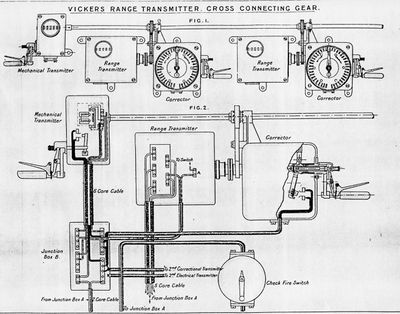Cross-Connecting Gear


Cross-Connecting Gear was a mechanical transmitter that could drive two or more Vickers F.T.P. transmitters so that a single hand-worked mechanical range or deflection transmitter could convey data to a plurality of separately wired, remote receivers.
Function
Previously, the transmitting station would require a separate pair of range and deflection transmitters be worked for each and every gun mount that was to be fired at the given target. This crowded the Transmitting Station with more men, and increased the possibility of human errors in transmission.
This innovation may have first appeared in 1910 with Vickers Mark III* transmitters. By 1914, a new Mark IV* family was introduced for first use in the Queen Elizabeth class.
Correctional Gear
"Correctional Transmitters" were supplied which could, by means of a differential, allow individual slaved transmitters to have a bias applied. This was meant to improve upon a correctional gear first tried in Dreadnought which had been found less than fully satisfactory. The mechanical shaft had sliding sleeves which could permit transmitters to be clutched in or out of the mechanism.
The rationale for fitting the "correctional gear" was to provide a means by which spotting corrections could be applied to the range clock range. That is, the mechanical transmitter would send out range clock, or geometric ranges and the correctors would allow the range actually sent out electrically to incorporate spotting corrections – a function later fulfilled by spotting correctors. This solution was inelegant, in that the plates suggest that the spotting corrections would have to be dialed into a separate corrector transmitter for each gun mounting.
There were right- and left-handed patterns of the gear.[3]
See Also
Footnotes
Bibliography
- Admiralty, Gunnery Branch (1914). Handbook for Fire Control Instruments, 1914. G. 01627/14. C.B. 1030. Copy 1235 at The National Archives. ADM 186/191.
- H.M.S. Vernon. Annual Report of the Torpedo School, 1910, with Appendix (Wireless Telegraphy). Copy 436 at The National Archives. ADM 189/30.